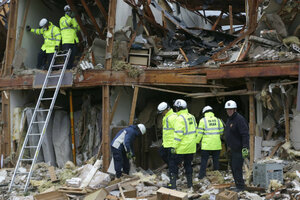Volunteer firefighting force decimated in Texas fertilizer plant explosion
At least 11 firefighters – most of them volunteers – appear to have died in a huge explosion and fire at a fertilizer plant in West, Texas, reports signal. Much of the nation relies on volunteer firefighters.

Firefighters conduct a search and rescue operation at an apartment building destroyed by a huge explosion at a fertilizer plant in West, Texas, on Thursday. The blast killed as many as 15 people and injured more than 160, including three firefighters, officials said overnight.
LM Otero/AP
Los Angeles
Early reports that at least 11 firefighters, mainly volunteers, are unaccounted for and believed killed in the massive fire and explosion at a fertilizer plant in West, Texas, Wednesday night are refocusing attention on the role of volunteer fire departments in the US, especially in rural areas.
So far, 12 people are confirmed dead and more than 200 injured, according to the Texas Department of Public Safety. Many of those killed and found in the vicinity of the explosion are believed to be first responders, according to the Dallas Morning News.
For a small town, such a loss can be devastating. "Basically, the West VFD is without two-thirds of their members at this point," reported the State Firemen's & Fire Marshals' Association of Texas on its website on Friday. Of the 29 firefighters on the town's roster, five have died and 11 others are hospitalized with injuries, it reported.
Very small towns depend on all-volunteer departments and, it turns out, so does the country as a whole. Forty percent of the US population is now protected by volunteer firefighters – saving taxpayers an estimated $130 billion annually.
The national trend is that such departments are declining in size as the average age of volunteer firefighters is increasing. Because they are drawn from the pool of regular folks who populate the area – accountants, teachers, insurance agents, store clerks – odds are high that victims will be well-known by others on a first-name basis.
The town “needs your prayers,” West Mayor Tommy Muska told reporters Thursday.
Country music icon Willy Nelson announced that he will donate the proceeds from his April 28 concert in Austin to support the West Volunteer Fire Department.
“West is just a few miles from my hometown of Abbott," he said on his web page. "I was born and raised here and it was my backyard growing up. This is my community. These friends and neighbors have always been and are still a part of my life. My heart is praying for the community that we call home.”
Now a rural town of just under 3,000, West grew up around a fresh-water spring with the help of Czech immigrants. A crossroads of grocery stores, churches, schools, and doctors offices, the town just 20 miles north of Waco has been decimated by the fertilizer plant explosion that has leveled dozens of homes and businesses.
National experts are hoping the episode can help focus attention on the country’s dependence on such volunteer departments, how valuable such volunteerism is, how appreciated such first responders are, and how broad their training needs to be.
Volunteers currently make up 69 percent of the firefighters in the US; that is, 756,450 of 1,100,450 firefighters are volunteer. Of the total 30,145 fire departments across the US, 20,200 are all-volunteer, 5,530 are mostly volunteer, 1,865 are mostly career, and 2,550 are all career. Here is a further breakdown regarding community size:
- Most career firefighters (73 percent) are in communities that protect 25,000 or more people.
- Most volunteer firefighters (94 percent) are in departments that protect fewer than 25,000 people.
- More than half are located in small, rural departments that protect fewer than 2,500 people.
“It is extremely impressive, that in America, thousands upon thousands are willing to put their lives on the line for a job that carries hidden hazards no matter how much training you’ve had,” says Philip Stittleberg, chairman of both the National Volunteer Fire Council and the National Fire Prevention Association.
Volunteer firefighters are the unsung heroes of every small town in America, he says. “Our hearts have to go out to those who have paid the ultimate price.”
Volunteers go through the same training that paid firefighters receive, but with fewer training hours, he adds, although many volunteers end up taking the same number of training hours required of paid departments.
Volunteer firefighters not only must be trained for dealing with fighting blazes and saving people from burning structures, but also are first responders for a long list of other duties – hazardous materials incidents, water rescues, high-angle and confined space emergencies (cats in trees, kids in wells), emergency medical incidents, natural disasters, and terrorist events.
Texas firefighters have been particularly pressed in recent years. With volunteer fire departments protecting 80 percent of the state, Texas was hit by the largest wildfire season in its history. Moreover, the Texas legislature and Gov. Rick Perry (R) recently cut by 70 percent a key grant program that funds volunteer fire departments. Some departments had volunteers battling out-of-control wildfires in street clothes, a potentially dangerous situation. The Grant Assistance fund used by the Texas Forest Service was cut last year to $14 million, down from the $50 million available in 2010-11.
"Volunteer fire departments make up 78 percent of the fire service in Texas, so their services are critically important to citizens," says Chris Birron, executive director of the State Firemen's & Fire Marshals' Association of Texas in Austin.
Asked for the lessons he hopes most Americans will glean from the West, Texas, episode, Mr. Stittleberg notes that locals everywhere are very welcome to help in many ways that are not considered front-line-danger capacities. Those include building and vehicle maintenance, accounting, fundraising, and teaching.

